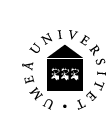Answers to exam 160111
Note that some of the solutions are too short for being OK on an exam
- (a) N=NA n, kB = R/NA, where NA=Avogadro's number
(b) Enthalpy is a useful quantity under constant pressure conditions. It is useful because it includes the work that is needed to change the volume which means that we don't need to keep track of these changes in the calculations.
- (a) Microstate = a state where all properties of all particles are listed. Macrostate = a state specified only by the total properties of the system (e.g. energy and magnetization). Multiplicity of a macrostate = the number of microstates that belong to that macrostate.
(b) S = kB log Ω, where Ω is the multiplicity.
(c) The entropy tends to increase.
- (a) dU = TdS -pdV + μdN gives
1/T=(∂S/∂U)VN
p/T=(∂S/∂V)UN
(c) Write S=N kB[ln V + const] → p/T= (∂S/∂V)UN = N kB/V gives the ideal gas law.
(c) Similar to (b) above
(d) Replace 3/2 in the exponent with f/2 and show that this leads to U=(f/2)N kB T.
- (a) Since maximum of ∑ si=N it follows that Smax = N
(b) Let δS be the value that makes P(S) a factor of e-1 smaller than the maximum → (δS/σ)2 = 1. After calculating σ1=1 from the distribution of si and using σ2 = Nσ1 follows δS/Smax = 1/N1/2.
(c) The relevance for physical systems is that the measured values of all kinds of macroscopic quantities will fluctuate a little around the value that really optimizes the multiplicity, but these fluctuations will be small enough to be entirely negligible.
- (a) From dU = T dS -p dV → -∮ pdV = ∮ dU - ∮ T dS. But ∮ dU has to vanish since we should be back to the same state after completed a cycle.
The work on the medium is then W = -∮ TdS = - (the area of the loop in the T-S-diagram) = -72 kJ. The work of the engine is the work done by the medium which is -W = 72 kJ.
(b) The efficiency is W/Qh = (Qh-Qc)/Qh = 1-Qc/Qh.
We then use Qh=Q23 = T2 (S3 - S2)
and Qc = -Q31 = (1/2)(T3 + T1) (S3 - S2)
which gives efficency ≈0.1
- For the two cases, freezer being indoors and outdoors, we have to calculate both COP = Qc/W and Qc. Here Qc is the amount of heat that has to be transported away which is equal to the amount of heat that leaks into the freezer from the outside. With Qc = kt Δ T (where kt is the thermal conductivity) and the optimal COP = Tc/Δ T the total saving becomes 75%.
- (a) We have Δ G = ΔGH2O - (1/2)ΔGO2 - ΔGH2 = -237 kJ (and similar calculations for ΔH and ΔS).
The extracted work = -ΔG = 237 kJ.
(b) From H = U+pV and G = U-TS+pV follows TS = H-G or Q = ΔH - ΔG.
We can alternatively use Q=TΔS (with ΔS from the table).
Both methods give Q=-48 kJ. The minus sign shows that heat is leaving the system as waste heat.
- Mixtures of two types of molecules
(a) This is the right Fig 5.26 in the textbook.
(b) This is shown in Fig 5.27.
(c) This means that for any finite temperature the free energy of a mixed phase will be lower than the free energy of the pure phase which means that it is always difficult to make a perfectly pure material.
- Thermodynamics of radiation
(a) S=(4/3)βVT3
(b) Vi Ti3 = Vf Tf3 → Tf=Ti(Vi/Vf)(1/3) = 500K
|

